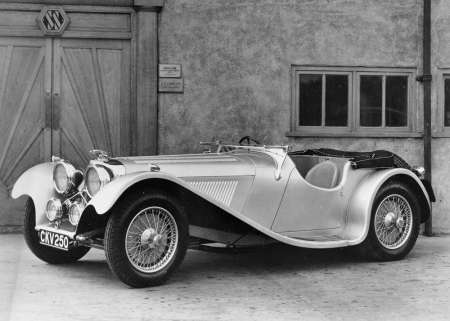Office Entrance, Jaguar Cars, Whitmore Park, Holbrooks
Jaguar Cars originally named Swallow Sidecar and Coachbuilding Company Limited, started business in Blackpool in 1922 manufacturing motorcycle sidecars. They expanded into car body coach building in 1927 making the Swallow body for Austin Sevens. However, the Blackpool site lacked space for further expansion and William Lyon made the decision to move himself and the whole company to Coventry. Their first site, opened in 1928, was in Whitmore Park, Holbrooks, where they occupied the two north-west blocks of a 16-block former White and Poppe World War One shell filling factory. By 1932 they had occupied half of the original site. About this time an office block built about 1915 and lying to the south–east of the main factory was also acquired, along with other smaller buildings. Further land was purchased in 1937 and 1938 to cater for the new pressed steel SS car body. Motor Panels was purchased for the same purpose in 1938 but sold to Rubery-Owen in 1941. Production developed in the 1930s to SS car bodies and the introduction of full vehicles in 1935. In 1939-40 an eight acre Air Ministry funded factory for the manufacture and repair of military aero components was built to the west of the original plant and in 1945 car production moved into the new plant.
In 1945 the company changed its name from SS cars to Jaguar Cars because of obvious wartime connotations. By 1950 the site comprised some 650,000 square feet of floor space was proving insufficient given the company’s post war expansion. William Lyon negotiated the lease of the former Daimler No. 2 Shadow Factory at Browns Lane in 1951. Full production was transferred to Browns Lane by November 1952 and the old site was sold for £443,000. Browns Lane was the site of all Jaguar production until 1998. Jaguar merged with the British Motor Corporation (BMC), the Austin-Morris combine, to form British Motor Holdings (BMH) in 1966. After merging with Leyland and Rover, the resultant company then became British Leyland Motor Corporation (BLMC) in 1968. Financial difficulties and the publication of the Ryder Report led to effective nationalisation in 1975 when the company became British Leyland Ltd (BL).
Office tradition has it that Walter Stanley Hattrell was associated with William Lyon “from the beginning” although office records fail to give an exact date of their first meeting. It is therefore possible that Hattrell and Worley had been involved in minor alteration work and repairs of the former shell-filling factory and associated buildings during these early years. About 1935-6 William Lyon ventured into “architecture” when the utilitarian offices were fitted with imposing set of front entrance doors. These doors comprised a timber surround with the SS monogram above. These letters were removed following the change in the company’s name in 1945, but the remainder was retained and survived until at least the 1980s. Opening on to stairs up to the Managing Director’s office, the doors are of Art Deco sunburst design and feature on a publicity photograph of the 1937 SS 100 Jaguar. Given their stylist similarity to other buildings in Coventry at this period it seems not unreasonable to attribute their design to Hattrell and Worley.
With war imminent, W S Hattrell and Partners were certainly employed by the company for necessary alterations to their works to allow the manufacture of aircraft components, and for works at a factory in South Wigston, Leicestershire. Nothing is yet known of this latter factory but it is assumed to be part of the Shadow Factory. Car production having ceased as a result of the war, motor manufacturers were put in charge .
